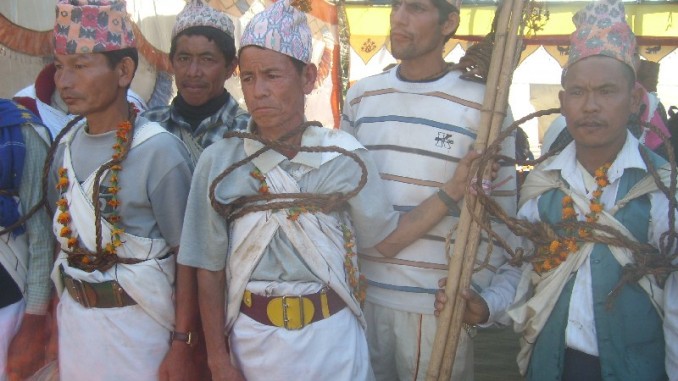
By Rup Narayan Dhakal– I know few about domestic honeybees and honey harvesting ideas since there was a beehive in my house but I was not so much familiar with cliff (wild) honeybees that could be seen in some of the high cliffs of Kaski district in Mid-Nepal. Fortunately, I got an opportunity of taking part in a Honey Hunting Festival (Nov 11-13, 2008) took place in Landruk (1,550m), a touristy village along with the Annapurna Region.
The festival began with Panchai Baja, the Nepalese traditional music, dances and a party in this mountainous village. The festival inaugurated amid the mass meeting. Most of the villagers living in the urban areas like- Pokhara and Kathmandu- for employment, study and easy livelihood were also present there. It was a sunny day that saw our 1 hour drive plus 3-hour hike from resort town Pokhara to Landruk. It was then 2 PM there in the village and 3 honey hunters were preparing themselves to fight against a high cliff where more than two dozens of beehives were hanging with honey combs. With a he-goat in the front part, honey hunters- Nakkal Bahadur Gurung, Min Prasad Gurung, Kharka Bahadur Pun including his crew members and villagers left for cliff site (Kote Sanghu), the half an hour downhill walk from the village, in the bank of Modi Khola River.
I was following the hunting team and taking some pictures of that bizarre event. As we arrived near the cliff that highs around 100 meters, a sacred procession was occurred and the he-goat was sacrificed in the name of god believing that the unexpected accident would not be occurred while honey hunting in the cliff. Right after the sacred procession, the hunting crew arrived in the brink of the cliff and started to unfold the long ladder they brought made of two-bamboo-fiber-ropes and wooden sticks (steps). After that, an end of the ladder was fastening in a tree’s base and another was thrown down the cliff. Now it was then a time of watching real bravery of real heroes. Nakkal Bahadur started to take the down steps of ladder hanging in the high cliff adjoining the beehives. As he came near the hive, he saw thousands of black bees (Apis laboriosa) and heard their buzzing.
I was at another bank of the river, two hundred meters far from the base of the cliff. I could see the webs upon the beehives created by bees to save themselves from their enemies. After few minutes, Nakkal Bahadur received a Smoky flame sent down in a rope by his colleagues helping him from the upside. As he neared the flame around the beehive to smoke the bee out, bees left their nest to save themselves. Then Nakkal Bahadur cut a honey comb using a metal spade attached in the end of a wooden rod that he had. After sending that comb up with a help of a rope that earlier sent down carrying smoky flame, he started to collect the honey in a bamboo basket that he got from the same rope. Then he sent the basket up. Turn by turn, Nakkal Bahadur and his colleagues reiterated such tasks to harvest the honey.
The job is equally risky too. According to villagers, Jangavir Kshetry died of fall from the ladder decade ago while on the hunting. Dozens of bees stag honey hunters while hanging on the cliff. However those real heroes tolerated that and showed the extreme adventure as a festival to the onlookers. At the same time, I was chased away by eight bees while I was trying to take some picture closely. However I again back near to the scene and took few photographs of honey hunting. I also tested the wild honey and found delicious but didn’t feel any dizziness though it was told that excessive consumption of such honey might make feel dizzy.
The villagers harvest honey twice in a month here in Landruk. But that time, Annapurna Sanctuary Tourism Entrepreneurs’ Committee (ASTEC) and local people jointly marked this task as a festival a decade later again. There are dozens of bee cliffs in Kaski district but they were not advertised in the market. Apis laboriosa’s honey, which is especially sought after in spring, is in high demand on the international market. It is said that people are ready to pay up to $15 per kg (2.2 lb). Experts have also designated Nepal as a honey-hunting destination for tourists. An ICIMOD report says that tourists who come to Nepal in a group are paying $250-$1500 to experience one honey-hunting event. It is said that locals should be made responsible for preserving the honeybees and their nests and for their management as well. The use of modern technology to hunt honey and inexperienced hunters are the major threats to the cliff bees and the preservation of their nests. At last, I would like to thank ASTEC then President Kisham Gurung, then Secretary Sam Bahadur Gurung, ACAP Ghandruk then representative Shyam Bahadur Gurung, tourism entrepreneur Taikaji Gurung, Pundit Ananda Poudel, Local club member Bij Man Gurung and local Ghanashyam Chapagain, who supported me to collect the information for this travelogue.

Leave a Reply